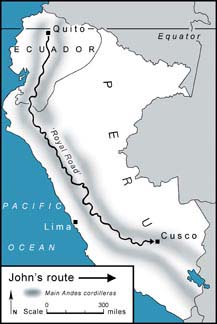
![]() Royal Road intro – First update – Previous update – Next update – Final update – Come to a talk!
Royal Road intro – First update – Previous update – Next update – Final update – Come to a talk!
Hitler made the trains run, and the generals who took power in Ecuador on 21st January have certainly got the buses going again. After a week of burning barricades on Ecuador’s main roads this is quite a relief. In truth the army only ruled for a few hours before handing over to a civilian government. I heard the story unfold on a Dayglo orange transistor radio, held aloft in the square of a tiny village high in the Andes, straining to listen over the heads and shoulders of villagers. The best place to be in a coup.
I was now in the far south of Ecuador and had just one stretch of the Royal Road still to investigate before moving on to Peru. It was a difficult one, high on a winding ridge overlooking the town of Saraguro, in a fiercely traditional area whose inhabitants still wear traditional costume – black full-length dresses with broad-rimmed sombreros for the women, black ponchos and ludicrous black baggy shorts for the men. The black is said to be in mourning for their lost ancestors, butchered by Atahualpa, the last Inca.
The highlight of my short time in Saraguro was, oddly enough, a funeral. A prematurely-born baby had died just five days old. I was to be the official photographer. On entering the house I found, to my horror, the deceased propped up on a ceremonial dias, dressed in a baby party frock, cheeks slightly purple and nostrils oozing snot. Sobbing pitifully, the parents laid it in a baby-sized silk-lined coffin, decorated it with rose petals and clamped shut the lid. Then, slowly at first, aunts, uncles, cousins and grandparents began to dance round the coffin, and as the pace of the music quickened everybody’s grief seemed magically to dissolve away. By the time the cortège had made its way across town to the cemetery it felt more like a May Day parade than a funeral. Even the gravedigger had a smile on his face.
On the ridgetop next day I wondered if the Incas buried their dead in the same pragmatic way. I was looking for the remains of a tambo or lodging-house, though with little hope of finding anything in the dense cloud-forest which clothed the mountains all around. But a couple of passing campesinos urged me on; then, in the thickest part of the forest, I came face to face with a man on horseback. “I’m looking for the Inca ruins,” I said. “You’re standing on them,” he replied.
Sure enough, on this narrowest, almost knife-edged
part of the ridge, huge square stones were protruding from the
dripping moss. Peering over the edge I could see them tumbling
down the mountain. Scraping away soil, I found a platform of masonry
almost intact. I stared in disbelief. This was exactly how Hiram
Bingham came across Machu Picchu nearly 100 years ago. Although
a humble tambo wasn’t quite of the same order as that
great showpiece of Inca architecture, I couldn’t help feeling
a small thrill that with the help of campesinos, who dance
round the coffins of their dead, the occasional discovery can
still be made.
